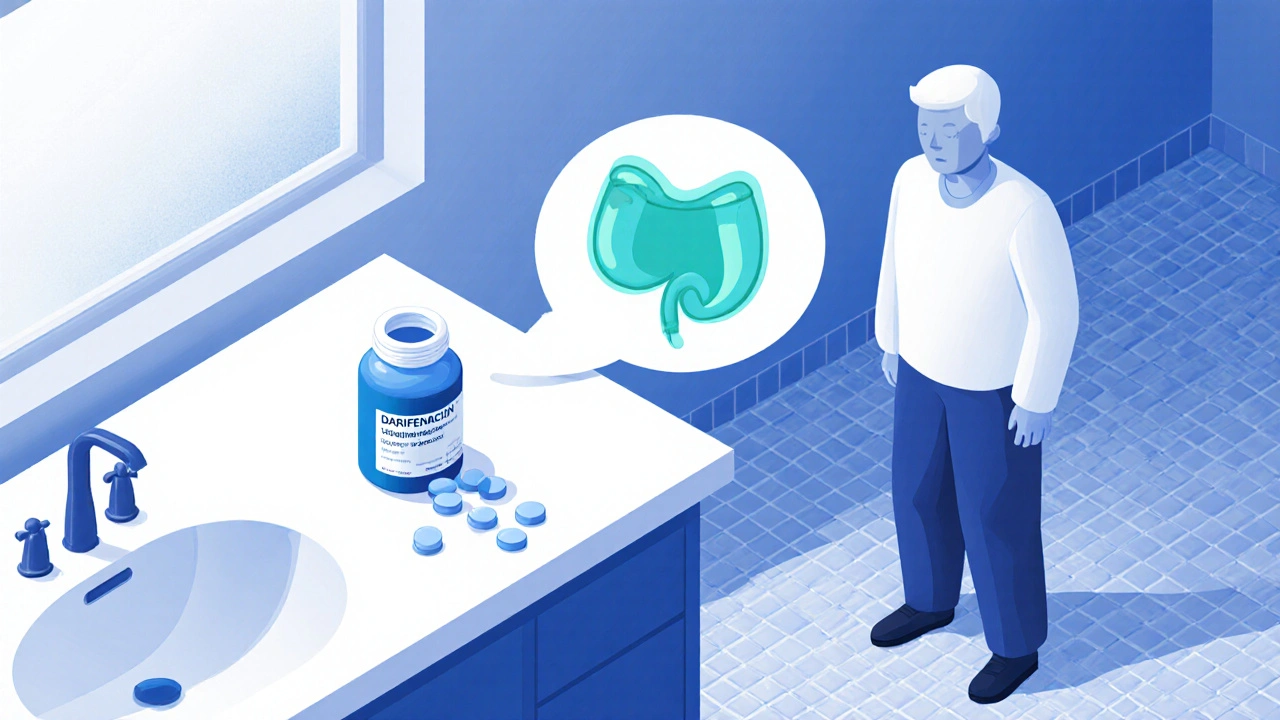Darifenacin Dosage Calculator
Calculate your appropriate Darifenacin dose based on age, liver function, and symptoms. Always consult your doctor before adjusting medication.
When you're prescribed a medication for overactive bladder, the first thing that pops into your head is usually: "What will it do to me?" Below is a straight‑talking rundown of the most common questions about Darifenacin a prescription anticholinergic used to treat urinary urgency, frequency, and incontinence caused by an overactive bladder. Darifenacin works by relaxing the bladder muscle so you can hold urine longer.
What condition does Darifenacin treat?
Darifenacin is approved for adults with Overactive bladder (OAB). OAB is characterised by a sudden urge to urinate, often accompanied by leakage (urge incontinence). It's not a disease, but a symptom complex that can stem from bladder muscle over‑activity, nerve signaling issues, or age‑related changes.
How should I take Darifenacin?
- Take the tablet once daily, preferably with food to improve absorption.
- Swallow the pill whole - don't crush or split it.
- If you miss a dose, take it as soon as you remember, unless it's near the time of your next scheduled dose. In that case, skip the missed tablet and resume your regular schedule.
The usual starting dose is 7.5 mg; many doctors will increase to 15 mg after a week if tolerable. Dose adjustments are common for older adults or patients with liver impairment.
What are the most common side effects?
Because Darifenacin blocks muscarinic receptors in the bladder, it can also affect the same receptors elsewhere. Expect at least one of these:
- Dry mouth - the most frequently reported complaint.
- Constipation - especially if you're already low on fiber.
- Blurred vision or difficulty focusing, a sign of anticholinergic impact on the eyes.
- Urinary retention - paradoxically, too much relaxation can make it hard to empty the bladder.
Serious side effects are rare but include severe constipation, tachycardia, and allergic reactions. If any symptom worsens quickly, call your doctor.
How does Darifenacin compare with other OAB meds?
| Feature | Darifenacin | Oxybutynin | Tolterodine |
|---|---|---|---|
| Mechanism | Selective M3 muscarinic antagonist | Non‑selective anticholinergic | Dual M2/M3 antagonist |
| Typical dose | 7.5-15 mg once daily | 5-10 mg twice daily (or extended‑release 10 mg daily) | 2-4 mg once daily |
| Dry‑mouth incidence | ~20% | ~30-40% | ~25% |
| Effect on cognition (elderly) | Low (high selectivity) | Higher risk | Moderate |
| FDA approval year | 2004 | 1975 | 2000 |
If you're sensitive to dry mouth, Darifenacin often feels gentler because it zeroes in on the bladder's M3 receptors, sparing many other tissues.
Can I take Darifenacin with other drugs?
Darifenacin is metabolised mainly by the liver enzyme CYP3A4. Anything that blocks or induces this enzyme can change the drug's levels:
- Inhibitors - e.g., ketoconazole, erythromycin, grapefruit juice. These can raise Darifenacin concentrations, upping side‑effect risk.
- Inducers - e.g., rifampin, carbamazepine, St. John’s wort. They may lower the drug’s effect, causing persistent urgency.
Other common interactions include antihistamines, tricyclic antidepressants, and antipsychotics, all of which share anticholinergic activity. The cumulative load can push you into blurry vision, severe constipation, or urinary retention.
Is Darifenacin safe for special populations?
Elderly patients: Because older adults often have reduced kidney and liver function, start low (7.5 mg) and monitor closely. The FDA label notes a higher risk of cognitive decline with high anticholinergic burden.
Patients with glaucoma: Anticholinergics can increase intra‑ocular pressure. If you have narrow‑angle glaucoma, discuss alternatives with your ophthalmologist.
Pregnancy & breastfeeding: There are limited data; the drug is classified as Category C. Avoid unless the benefit clearly outweighs the risk.
What should I do if I experience an adverse reaction?
- Stop the medication immediately if you develop severe constipation, inability to urinate, or a rapid heart rate.
- Contact your prescriber or go to urgent care. Bring the medication bottle so the clinician can verify the dose.
- For milder symptoms like dry mouth, increase fluid intake, chew sugar‑free gum, or use saliva substitutes.
Never adjust the dose on your own - always get guidance from a healthcare professional.
How long does it take to see improvement?
Most people notice reduced urgency within 1-2 weeks, but the full effect can take up to 4 weeks. Keep a bladder diary during this period to track frequency, volume, and any leak episodes. Sharing this diary with your doctor helps fine‑tune the regimen.
Frequently asked questions (FAQ)
Can I drink alcohol while taking Darifenacin?
Alcohol can increase the risk of dizziness and can worsen dry mouth. Moderation is key - limit to one standard drink a day and monitor how you feel.
Do I need to do any special tests before starting Darifenacin?
Your doctor will usually check kidney and liver function, and may do a post‑void residual volume test to ensure you can empty your bladder fully.
Is Darifenacin habit‑forming?
No. It does not cause dependence or withdrawal. However, stopping abruptly may bring back urgency symptoms, so tapering under medical supervision is advised.
What should I store Darifenacin like?
Keep the tablets in a cool, dry place away from direct sunlight. Do not refrigerate unless instructed.
Can Darifenacin be used in children?
It is not approved for pediatric use. Children with OAB are usually managed with behavioral therapy first.
Armed with these answers, you can talk to your clinician confidently, weigh the benefits against possible drawbacks, and decide if Darifenacin fits your lifestyle. Remember, the best outcome comes from a partnership between you and your healthcare team.
